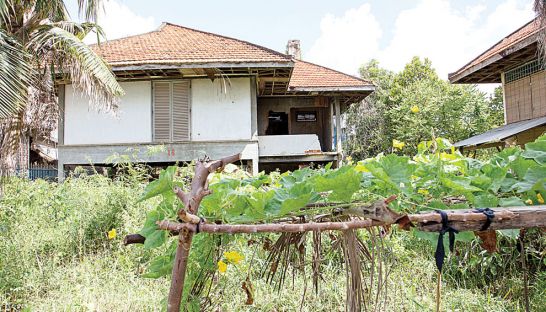Most of Phnom Penh’s arts scene is concentrated in a handful of central galleries, but if you poke around on the outskirts you might just stumble on one of the capital’s most unusual and overtly political works.
Last weekend, off a road on the way to the airport, a colourful tribute to renowned Cambodian architect Vann Molyvann was painted on one of his now-dilapidated designs which is earmarked for demolition.
The 10 or so derelict buildings in the area are all that remains of Molyvann’s 100 Houses Project, an initiative completed in 1967 that housed workers from the National Bank of Cambodia.
Molyvann, who studied at the School of Fine Arts in Paris, designed some of the capital’s most recognisable structures, including Independence Monument and the Chaktomuk Conference Hall.
Last weekend, a room inside one of these buildings – set back from the road and creeping with undergrowth – was painted as part of the Last Breath Project, a global movement to occupy pre-demolition buildings with art.
One room features artwork by Cambodian Kong Vollak and French street artists Al and Chifumi, whose work has covered walls around Pursat, Kampot and Siem Reap as well as Phnom Penh.
Facing the entrance to this room is an installation of sheets of folded paper upon which black windows are drawn. Stacked on top of one another, they creep up the corner, caged in by black towering shapes drawn on the surrounding walls.
The installation, by Kong Vollak, is entitled Goodbye Soon and reflects the creeping monotony of modern architecture in contrast to Molyvann’s unique style.
Thirty-year-old Vollak, who studied at the Royal University of Fine Art, said that he thought Molyvann would appreciate his work.

“I think he would see it as a message to the world to support the building before it is destroyed,” he said on the phone earlier this week.
The artist Chifumi said the that giant painted black and white hands are a celebration of the integration of Cambodian and French people – and a nod to the heavy French influence in Molyvann’s architecture.
“Vann Molyvann’s project was built in the same way as social architecture and urbanism in France.
“My idea was to speak of the cultural heritage that Cambodia has, between traditional Khmer culture, the culture of the French protectorate and the idea the government has of architecture now,” he said.
Chifumi added that the black hand is trying to escape the clasp of the white hand’s French heritage.
This installation is the third of its kind by the Last Breath Project, the brainchild of a 24-year-old Belgian who goes by the name Tom. Having exhibited art in derelict buildings in London, he is now travelling around the world attempting to breathe life into old structures in an act of defiance against rapid development.
“Here people get kicked out of their houses to fill a lake”, he said, referring to the forced evictions of communities in the Boeung Kak area.
He added: “We’re celebrating a building, and it deserves to be beautified, to have a last breath of life before it disappears.”
“If you have rapid development, you have rapid destruction of things, and it’s good for a moment to just stand still.”
It’s hard to know exactly when the building will be demolished, said Tom, who learned of the demolition from the Vann Molyvann Project. It could be any day now, or it could be a number of months.
Yam Sokly, an architect who runs tours of Molyvann’s buildings, called Molyvann’s work is part of Phnom Penh’s cultural heritage. “Phnom Penh has it own unique architectural and urban landscape. These are part of our city and national identity,” he wrote in an email.
He added: “I think Molyvann would be so pleased with this project. He would totally support this initiative. But with his current health condition, it might difficult for him to decide or even give advice.”
Molyvann, who is believed to be in poor health, could not be reached for comment. In a 7Days interview last year in which he was asked how he felt about his buildings being destroyed to make way for new developments, he said: “I feel extremely sad.”
To find the site, drive along Russian Boulevard until you come to the Toyota dealership, and go right down a lane between that and the TELA garage. Go to the end of this street, then right. Take your first left, and then the third left, onto the lane parallel to the rail tracks. The house is the second on the left hand side.
Source: Phnom Penh Post

